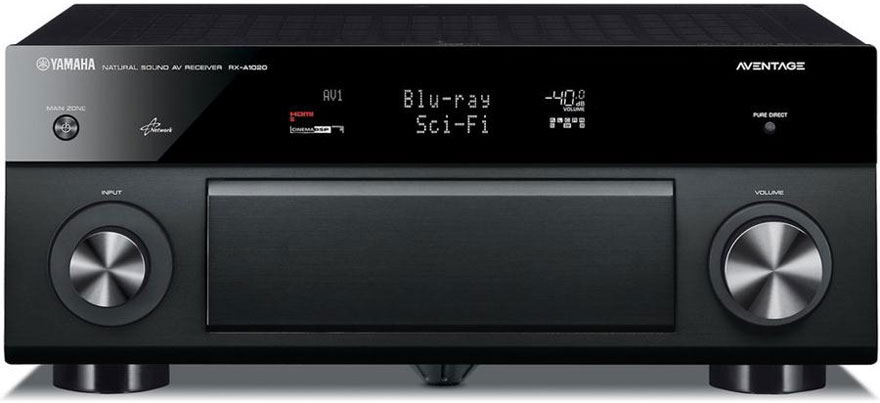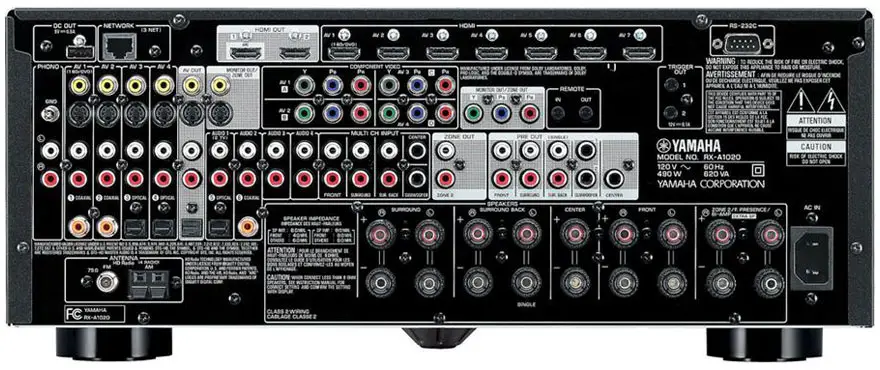Any AV receiver that is priced above $1,000 needs to make a very good impression in the audio quality department. This is where hardware technologies aren’t the only things that you have to rely on in order to be successful. The overall design of the AV receiver is also important so music sources are reproduced in the most accurate way possible. Of course, only serious audiophiles need that kind of accuracy which is why $1,000+ AV receivers like the Yamaha RX-A1020 target that kind of audience. But even at that price level, there is some serious competition coming from players that have also been manufacturing AV receivers for years. This RX-A1020 review will determine if this ambitious AV receiver has what it takes to take on the other AV receivers that strive for perfection on the studio level.

Design
As mentioned earlier, the design counts a lot when it comes to the overall performance of the AV receiver and the RX-A1020 fortunately delivers in that end. On the outside, the Yamaha RX-A1020 looks pretty sleek with an aluminum front panel which is just what the AV receiver needs if it wants to shield the sensitive circuitry from radiation. This means that you can operate the RX-A1020 in just about any type of environment and get the same optimum audio performance.
Unlike the cheaper Yamaha AV receiver models, you need to lift down the small front panel to reveal the buttons and front panel ports. The HDMI front panel input is one of them and it allows modern portable gadgets to be hooked up. iPods and other Apple gadgets can be hooked up to the USB port which also delivers power to these devices. The SCENE buttons can also be found beneath the panel but they look a bit smaller. However, the Yamaha RX-A1020 utilizes the SCENE PLUS function which lets you select one of the 12 customizable SCENE selections where the DSP mode and input source can be stored. 4 of them can be assigned to Zone 2 if you decide to go with a multi-zone configuration.
Internally, Yamaha designed the RX-A1020 in such a way that the power amplifier layout is symmetrical in order to maximize channel separation. This design approach isolates the left and right channels to boost the signal-to-noise ratio and widen the sound stage. Yamaha also ensured that every internal component of the AV receiver was carefully designed and tested to meet the high standards in performance. Finally, the Yamaha RX-A1020 uses the Anti-Resonance Technology Wedge which is another design approach that features five feet instead of four feet on the bottom of the AV receiver so any vibrations from the speakers don’t affect the sound quality.
Below is the back panel layout. Click on image to enlarge for a clearer view.

Features
The RX-A1020 features a number of premium technologies to back up the hardware advancements. On the video side, the Yamaha RX-A1020 supports both 4K pass-through as well as 4K upscaling so the AV receiver can make the most out of the upcoming 4K super high-resolution displays. Lower resolution images can be upscaled so 480p, 720p and 1080p videos look great on the large displays. 3D HDMI pass-through is supported as well for home theater systems that consist of a 3D display and 3D Blu-ray player.
The usual Dolby TrueHD and DTS-HD Master Audio technologies are incorporated to the RX-A1020 to bring out the best of the current high-definition content offered by Blu-ray media. These basic technologies work together with some of the more exclusive ones like CINEMA DSP 3D which is a special mode which can provide power to the two front presence speakers to create a 3-dimensional sound. Even if you don’t have that type of configuration, the AV receiver’s VIRTUAL Presence Speaker mode can create a similar effect to make the sound field higher and denser. For multi-zone audio system configurations, the Zone2 feature can be activated so the main system can utilize a 5.1-setup while the other room can play extended sound on a stereo setup. The second HDMI output can also extend the video to another display. You can optionally assign the Zone2 video to older components like composite, S-video and component.
Some other enhancements can be applied to audio depending on what is currently playing. For instance, the Compressed Music Enhancer can improve the quality of any MP3s with low bitrates. Movies with lots of dialog can also be enhanced by using the Dialog Level Adjustment function which can also be used to add clarity to the music vocals.
Calibrating the Yamaha RX-A1020 is quite similar to calibrating any other receiver as it involves the use of a small microphone which you need to plug in and place on the listening area so each speaker is properly configured. But the YPAO Automatic System Calibration which the RX-A1020 is a bit more sophisticated because it checks the connections of each speaker as well as the phase. So many factors are considered when calibrating including the distance of the speakers, sound pressure level and speaker size.
One of the best things about controlling the Yamaha RX-A1020 is the various ways to do so. The RX-A1020 supports AirPlay so any mobile device like an iPhone or an iPad can use iTunes to stream music to the AV receiver wirelessly. Laptop and PCs with iTunes installed can do the same as well. In addition to speaker angle measurement, reflected sound control is employed as well to correct early reflections. For controlling other functions such as zone controls, you can simply download the free Yamaha AV Controller app to an Android, iOS or Kindle Fire device and enjoy the convenient touchscreen controls wherever there is Wi-Fi signal.
Bottom Line
The Yamaha RX-A1020 is definitely a worthy choice because of the good engineering decisions as well the wide array of technologies being offered. Yamaha even managed to take power consumption into consideration which is quite rare for a studio-quality AV receiver. It has the same standby features and ECO mode so it is possible to use this highly powered AV receiver for a fairly small configuration. It is unlikely for these kinds of users to replace this AV receiver because there are a total of 8 HDMI ports and plenty of other connectivity to make this a good choice when the home theater needs upgrading.
Update: There is a newer model > Yamaha RX-A1050